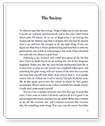Essay Instructions: Open to all writers!!
CULTURAL SELF-ASSESSMENT INSTRUCTIONS
AND GRADING RUBRIC
This exercise will allow you to do some self-reflection related to cultural competency. In order to complete this exercise, follow the instructions listed below:
CRITERIA POINTS POSSIBLE POINTS EARNED
1. Go to the Cultural Competence Self-Test link provided and complete the questions related to cultural competency.
2. After completing the questions, write a brief narrative (1–2 pages) explaining what you learned from completing the exercise.
3. Identify areas of opportunity for growth. Note: This area may require more information/education related to a particular culture or population. 25
4. Discuss how you could better incorporate cultural competence into your practice. 15
5. Submit your completed assignment as a Microsoft Word document via the View/Complete Assignment link in Module 2 Assignments no later than 11:59 p.m. (ET) on Sunday of that week.
TOTAL POINTS 40
Cultural competence selftest
The following self-assessment can assist physicians in identifying areas in which they might
improve the quality of their services to culturally diverse populations.
Promoting Cultural and Linguistic Competency
Self-Assessment Checklist for Personnel Providing Primary Health Care Services
Directions: Please enter A, B or C for each item listed below.
A = Things I do frequently
B = Things I do occasionally
C = Things I do rarely or never
Physical Environment, Materials & Resources
____ 1. I display pictures, posters, artwork and other decor that reflect the cultures and
ethnic backgrounds of clients served by my program or agency.
____ 2. I ensure that magazines, brochures and other printed materials in reception areas
are of interest to and reflect the different of individuals and families served by my program or
agency.
____ 3. When using videos, films or other media resources for health education, treatment or
other interventions, I ensure that they reflect the cultures and ethnic background of
individuals and families served by my program or agency.
____ 4. I ensure that printed information disseminated by my agency or program takes into
account the average literacy levels of individual families receiving services.
Communication Styles
5. When interacting with individuals and families who have English proficiency, I always keep
in mind that:
____ Limitations in English proficiency are in no way a reflection of their level of
intellectual functioning.
____ Their limited ability to speak the language of the culture has no bearing on their
ability to communicate effectively in language of origin.
____ They may or may not be literate in their language of origin or English.
____ 6. I use bilingual-bicultural staff and/or personnel and volunteers skilled or certified in
the provision of medical interpretation treatment, interventions, meetings or other events for
individuals and families who need or prefer this level of assistance.
____ 7. For individuals and families who speak languages other than English, I attempt to
learn and use key words in their language so that I am better able to communicate with them
during assessment, treatment or other interventions.
____ 8. I attempt to determine any familial colloquialisms used by individuals or families that
may have an impact on assessment, treatment or other interventions.
____ 9. When possible, I ensure that all notices and communiqués to individuals and families
are written in their language of origin.
____ 10. I understand that it may be necessary to use alternatives to written
communications for some individuals and families, as word of mouth may be a preferred
method of receiving information.
Values & Attitudes
____ 11. I avoid imposing values that may conflict or be inconsistent with those of cultures or
ethnic groups other than my own.
____ 12. I screen books, movies and other media resources for cultural, ethnic or racial
stereotypes before sharing them with individuals and families served by my program or
agency.
____ 13. I intervene in an appropriate manner when I observe other staff or clients within my
program or agency engaging in behaviors that show cultural insensitivity, racial biases and
prejudice.
____ 14. I recognize and accept that individuals from diverse backgrounds may desire
varying degrees of acculturation into dominant culture.
____ 15. I understand and accept that family is defined differently by other cultures (e.g.,
extended family members, fictive kin, and godparents).
____ 16. I accept and respect that male-female roles may vary among different cultures and
ethnic groups (e.g., who makes major decisions for the family).
____ 17. I understand that age and life-cycle factors must be considered in interactions with
individuals and families (e.g., high value placed on the decision of elders, the role of eldest
male or female in families, or roles and expectation of children within the family).
____ 18. Even though my professional or moral viewpoints may differ, I accept individuals
and families as the ultimate decision makers for services and supports impacting their lives.
____ 19. I recognize that the meaning or value of medical treatment and health education
may vary greatly among cultures.
____ 20. I accept that religion and other beliefs may influence how individuals and families
respond to illnesses, disease and death.
____ 21. I understand that the perception of health, wellness and preventive health services
have different meanings to different cultural or ethnic groups.
____ 22. I recognize and accept that folk and religious beliefs may influence an individual's
or family's reaction and approach to a child born with a disability, or later diagnosed with a
disability, genetic disorder or special health care needs.
____ 23. I understand that grief and bereavement differ by culture.
____ 24. I seek information from individuals, families or other key community informants that
will assist in service adaptation to respond to the needs and preferences of culturally and
ethnically diverse groups served by my program or agency.
____ 25. Before visiting or providing services in the home setting, I seek information on
acceptable behaviors, courtesies, and customs that are unique to the culturally and
ethnically diverse groups served by my program or agency.
____ 26. I keep abreast of the major health concerns and issues for ethnically and racially
diverse client populations residing in the geographic locale served by my program or agency.
____ 27. I am aware of the socioeconomic and environmental risk factors that contribute to
the major health problems of culturally, ethnically and racially diverse populations served by
my program or agency.
____ 28. I am well versed in the most current and proven practices, treatments and
interventions for major health problems among ethnically and racially diverse groups within
the geographic locale served by my agency or program.
____ 29. I avail myself to professional development and training to enhance my knowledge
and skills in the provision of services and supports to culturally, ethnically, racially and
linguistically diverse groups.
____ 30. I advocate for the review of my program or agency's mission statement, goals,
policies and procedures to ensure that they incorporate principles and practices that
promote cultural and linguistic competence.
How to use this checklist
This checklist is intended to heighten the awareness and sensitivity of personnel to the
importance of cultural and linguistic competence in health and human service settings. It
provides concrete examples of the kinds of beliefs, attitudes, values and practices that foster
cultural and linguistic competence at the individual or practitioner level. There is no answer
key with correct responses. However, if you frequently responded "C," you may not
necessarily demonstrate beliefs, attitudes, values and practices that promote cultural and
linguistic competence within health care delivery programs.
Self-assessment developed by Tawara D. Goode, Georgetown University Child Development
Center-UAP. Adapted with permission Promoting Cultural Competence and Cultural Diversity
in Early Intervention and Early Childhood Settings and Promoting Cultural Competence and
Cultural Diversity for Personnel Providing Services and Supports to Children With Special
Health Care Needs and Their Families (June 1989? latest revision July 2000


